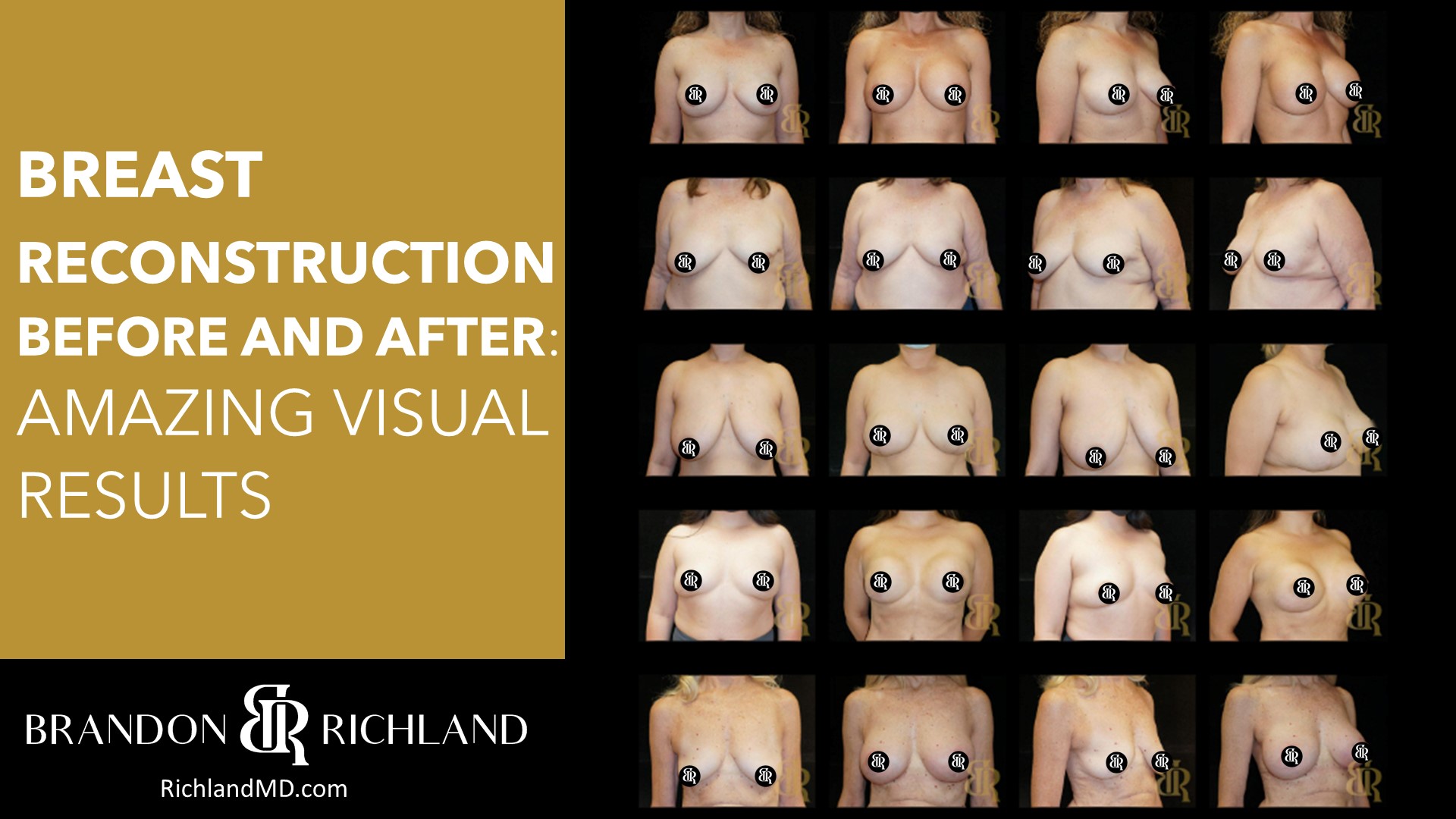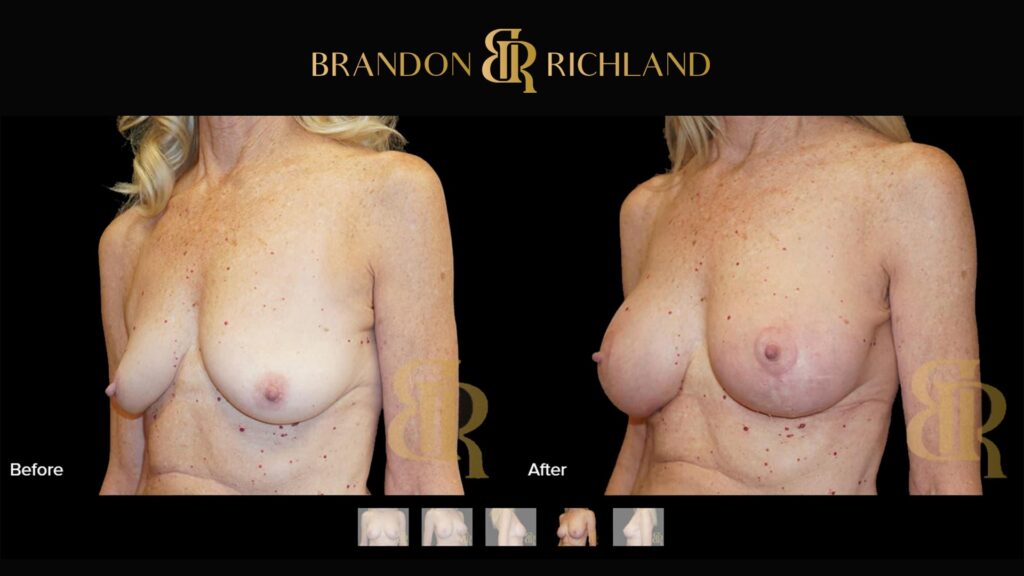Published by Dr. Brandon Richland, MD

Breast reconstruction can restore confidence and help women feel whole again after a mastectomy. This surgery involves rebuilding the shape of the breast to match its appearance before cancer treatment. Women opting for this procedure can see dramatic transformations, which can have a positive impact on their mental and emotional well-being.
For those looking to understand what these changes might look like, many offer thousands of breast reconstruction before and after photos shared by doctors. These visuals can provide a clearer idea of the potential outcomes of breast reconstruction procedures. Seeing real-life examples can help future patients set realistic expectations and feel more prepared for their own journey.
Key Takeaways of Breast Reconstruction Before and After
- Breast reconstruction rebuilds the breast shape post-mastectomy.
- Options include implants and using body tissue, with immediate or delayed timing.
- Viewing before and after photos helps set realistic expectations.
Understanding Breast Cancer
Breast cancer is a disease where cells in the breast grow out of control. Knowing how to screen for and treat breast cancer is crucial for early detection and effective management, including surgeries like mastectomy and lumpectomy.

Breast Cancer Screening
Screening helps find breast cancer early when it is easier to treat. Mammograms are the most common screening tests. These X-ray images of the breast can detect tumors that are too small to feel. Women aged 40 and over should get a mammogram every 1-2 years.
Breast self-exams and clinical breast exams are also important. A breast self-exam involves a person checking their own breasts for lumps or changes. Doctors or nurses perform clinical breast exams during routine physical exams.
Other screening methods include ultrasounds and MRI for those at high risk. Early detection methods improve survival rates and treatment outcomes.
Overview of Breast Reconstruction
Breast reconstruction is a type of surgery that rebuilds the breast after a mastectomy or lumpectomy. There are various options available, and the timing of the reconstruction can vary based on individual circumstances.
Immediate vs. Delayed Reconstruction
Immediate reconstruction happens at the same time as the mastectomy. This can shorten the total number of surgeries and recovery time. Patients may wake up from their mastectomy surgery with a reconstructed breast in place, which can be emotionally comforting.
Delayed reconstruction is done after the mastectomy, sometimes months or even years later. This allows time for other treatments like chemotherapy or radiation. It might also be chosen if the patient wants to spend more time considering reconstruction options.
Both choices have pros and cons. Immediate reconstruction offers faster cosmetic results, while delayed reconstruction may offer more flexibility in planning and medical treatment coordination.

Reconstruction Options
There are two main types of breast reconstruction: implant reconstruction and flap reconstruction.
Implant reconstruction uses silicone or saline implants to recreate the breast. This option often involves a shorter initial surgery and quicker recovery. It might require multiple surgeries over time to replace or revise implants.
Flap reconstruction uses tissue from another part of the patient’s body, such as the abdomen or back, to rebuild the breast. This method tends to look and feel more natural. It involves a longer surgery and recovery period but can result in more durable outcomes.
Breast Reconstruction Techniques Explained
There are several techniques for breast reconstruction, each with its own methods and benefits.
Flap Reconstruction Varieties
Flap reconstruction uses tissue from other parts of the body to create a breast shape. The DIEP flap uses skin and fat from the abdomen while preserving the muscles. The SIEA flap is similar but takes blood vessels from the abdomen’s lower area.
The TUG flap uses tissue from the inner thigh, including skin, fat, and sometimes part of the gracilis muscle. The Latissimus Dorsi (LD) flap uses muscle, fat, and skin from the upper back, often combined with an implant.
Other types include the TRAM flap, which uses muscle and tissue from the abdomen, and the IGAP and SGAP flaps, which use tissue from the buttock area. The PAP flap uses tissue from the back of the thigh. Each option has unique benefits and considerations, such as scarring or recovery times.

Implant-Based Reconstruction
Implant-based reconstruction involves inserting a breast implant to create a new breast shape. This technique can use either saline or silicone implants.
A tissue expander is often placed beneath the skin and muscle after mastectomy to stretch the area over time. This expander is gradually filled with saline solution to prepare the skin and tissue for the permanent implant. The implant can then be inserted in a second surgery.
Implant-based reconstruction often requires less surgical time upfront but might need future surgeries for maintenance or replacement. It’s essential for patients to weigh the pros and cons of saline versus silicone implants in terms of feel, appearance, and risks.
Nipple and Areola Reconstruction
Nipple and areola reconstruction usually happen after the breast has been reshaped and healed. One method involves shaping skin from the reconstructed breast to form a new nipple.
Life After Reconstruction Surgery
After breast reconstruction surgery, the recovery journey involves healing, monitoring, and sometimes additional procedures to achieve the best results. It’s important to be aware of what to expect in the days and months that follow.
Recovery and Healing
Recovery from a breast reconstruction procedure varies from person to person. In the first few days, some discomfort, swelling, and bruising around the surgery site are normal. Pain management usually includes prescription medications to help reduce any discomfort.
Patients might be able to begin showering 48 hours post-surgery but should confirm this with their healthcare provider. Light activities and short walks can aid in breast surgery recovery, though heavy lifting and strenuous activities should be avoided for several weeks.
Fluid build-up, or seroma, can occur at the surgery site, sometimes requiring drainage. Infections and bleeding are other risks, so monitoring for signs such as redness, warmth, or unusual drainage is crucial. It’s essential to follow all post-op care instructions and attend all follow-up appointments.

Follow-Up Procedures
Once the initial healing phase has passed, follow-up procedures may be necessary. Some patients may need revisions to enhance the symmetry and appearance of the breasts. This can include procedures to address any issues with implants or to refine the results from tissue flap surgeries.
Regular check-ups are crucial in detecting any recurrence of cancer. This includes breast exams and imaging tests. Discussions with the medical team are important to address any concerns related to new symptoms or changes.
Frequently Asked Questions About Breast Reconstruction Before and After
1. What Should I Expect in Terms of Appearance With Breast Reconstruction After a Mastectomy?
Post-surgery, reconstructed breasts will aim to resemble natural breasts in size and shape. Results vary based on the technique used and individual healing. Scarring is common, but many find the aesthetic improvement satisfying.
2. What Are The Different Breast Reconstruction Options Available After a Mastectomy?
Options include implants or autologous tissue reconstruction. Implants use saline or silicone, while autologous methods use the patient’s own tissue. Immediate and delayed reconstruction approaches are available, each with different timelines and recovery periods.
3. How Does Fat Grafting Work in The Context of Breast Reconstruction, and What Are Typical Outcomes?
Fat grafting involves taking fat from another part of the body and injecting it into the breast. This technique can improve shape and symmetry. Results often show natural-looking contours, but multiple sessions may be needed for optimal results.

Conclusion and Summary of Breast Reconstruction Before and After: Amazing Visual Results
Delayed breast reconstruction offers a viable option for most women considering their individual body type and personal circumstances. The use of tissue expanders can help prepare the chest wall for the final reconstruction, contributing to more satisfactory individual results. While every case is unique, the overall goal is to restore a sense of normalcy and ease after a challenging journey.
Dr. Richland, MD, and the entire team at our practice remain dedicated to providing comprehensive care tailored to each patient’s needs. Our gallery showcases various before and after photos, allowing potential patients to watch and click through real-life transformations. We understand the importance of involving family in the decision-making process, ensuring that each patient feels supported every step of the way.
Ultimately, while breast reconstruction does not cure the underlying cause of breast removal, it plays a crucial role in the emotional and physical healing process.
Please note that this article is intended for informational purposes only and should not be construed as medical advice. Before making any changes to your treatments, please consult with your healthcare provider to discuss the appropriateness and safety of such changes.
Ready For Your First-Class Cosmetic Experience in Orange County (OC) California (CA)?
Are you located in one of these Orange County (OC) / Southern California cities?
Aliso Viejo, Anaheim, Brea, Buena Park, Costa Mesa, Coto de Caza, Cypress, Dana Point, Fountain Valley, Fullerton, Garden Grove, Huntington Beach, Irvine, La Habra, La Palma, Laguna Beach, Laguna Hills, Laguna Niguel, Laguna Woods, Ladera Ranch, Lake Forest, Los Alamitos, Mission Viejo, Newport Beach, Orange, Placentia, Rancho Santa Margarita, San Clemente, San Juan Capistrano, Santa Ana, Seal Beach, Stanton, Tustin, Villa Park, Westminster, or Yorba Linda?
Plastic Surgeon Dr. Brandon Richland, MD and our Cosmetic Aesthetics Team are ready to help you look and feel your absolute best.
Elevate your confidence and self esteem levels to unfathomable new heights!
Schedule your in-person consultation in our modern and luxurious offices in either Fountain Valley, CA (Main HQ) or our Newport Beach, CA office.
Do you live outside of Southern California or short on time? For your convenience, Virtual Consultations are also available.
Our warm and engaging Team of carefully selected Aesthetics Professionals will make you feel calm, cool, collected, and right at home throughout your entire consultation and surgery process.
Schedule Your Aesthetics Consultation here, or call us directly at 949-867-4496 today.
About the Author

Dr. Brandon Richland, MD is a respected Board Certified Licensed Plastic Surgeon in Orange County / Southern California specializing in cosmetic and reconstructive surgeries.
Driven by his passion for medicine, Dr. Richland obtained his Doctor of Medicine (M.D.) degree from the prestigious program at Saint Louis University (SLU) School of Medicine in 2013. His exceptional skills were recognized when he received the McGraw Hill / Lange Medical Student Academic Achievement Award, and graduated top of his class with Honors. For his undergraduate degree, he attended University of California, Los Angeles (UCLA) and graduated with Honors in 2009.
To further enhance his surgical expertise, Dr. Richland completed his Residency in Plastic Surgery at the University of California, Irvine (UCI) from 2013 to 2019 earning the Academic Achievement Award twice during this period. A total of 14 years in dedicated schooling and medical residency.
Dr. Richland is actively involved with healthcare and medical societies, as a Diplomate of the American Board of Plastic Surgery, a member of the American Society of Plastic Surgeons, American Society of Aesthetic Plastic Surgeons, and the California Society of Plastic Surgeons.
Contact Dr. Richland today by visiting RichlandMD.com, scheduling a cosmetic consultation, or by calling 949-867-4496 directly.










